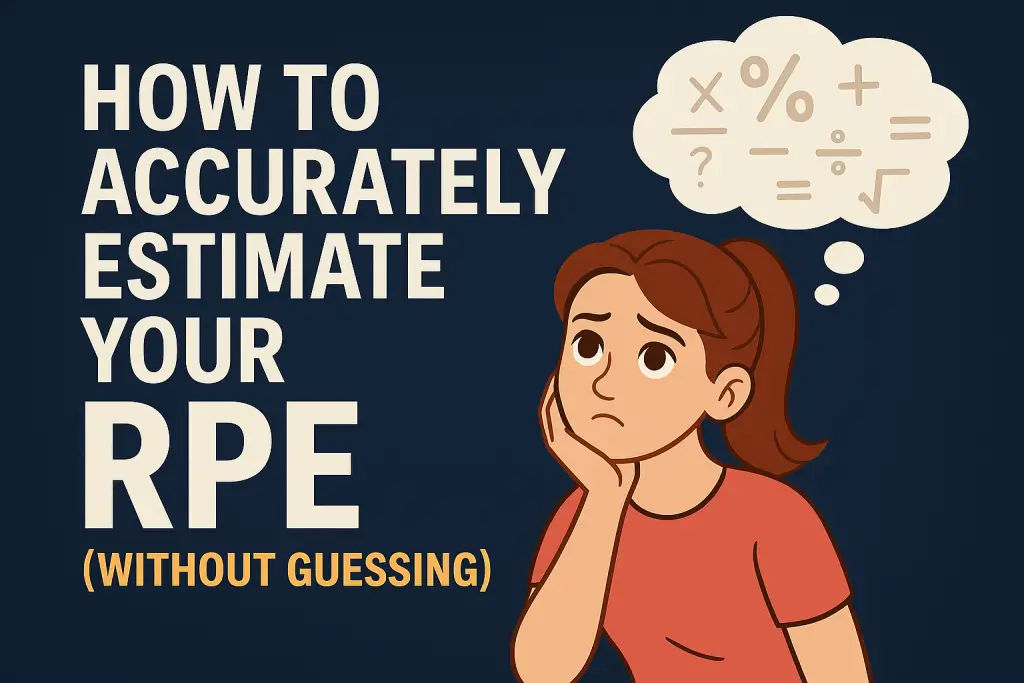How to Accurately Estimate Your RPE (Without Guessing)

Let’s be honest: estimating RPE (Rate of Perceived Exertion) can feel like a guessing game — especially when you’re just starting to use it in your training.
How do you know if that set was a 7 RPE or a 9 RPE?
What does “3 reps in reserve” actually feel like when you’re breathing hard and sweating?
The good news: with the right tools and a bit of practice, you can learn to dial in your RPE estimates with surprising accuracy.
In this article, we’ll walk through:
- What RPE actually feels like in the gym
- How to sharpen your accuracy over time
- The biggest mistakes people make when estimating RPE
- Tools you can use to make better decisions
Quick Refresher: What Is RPE?
RPE stands for Rate of Perceived Exertion. It’s a subjective scale — usually from 1 to 10 — that helps lifters describe how hard a set felt:
| RPE | Reps in Reserve (RIR) | Description |
|---|---|---|
| 10 | 0 | Max effort — no reps left |
| 9 | 1 | Could’ve done 1 more rep |
| 8 | 2 | Could’ve done 2 more reps |
| 7 | 3 | Light effort, room to push more |
Want a full breakdown? Check out our RPE and RIR Guide.
Why Is It So Hard to Estimate RPE Accurately?
Because it requires honest self-awareness — and most people:
- Overestimate how hard they’re working
- Underestimate how close they are to failure
- Change their perception depending on fatigue, mood, or confidence
That’s normal. But it’s also fixable.
5 Ways to Get Better at Estimating RPE
1. Record Yourself Lifting
Filming your top sets gives you visual feedback. You might feel like you’re grinding, but a video might show bar speed barely slowing. That’s a clue you had more in the tank.
🎥 Pro Tip: Look for bar speed, sticking points, and rep consistency.
2. Start Tracking Reps in Reserve (RIR)
If RPE feels too abstract, flip it. Use RIR instead:
- After each set, ask: How many more reps could I have done?
- Be honest. Most beginners are 2–3 reps off at first — but you’ll improve fast.
Once you’re confident with RIR, convert it to RPE. (2 RIR = RPE 8)
3. Use Back-Off Sets to Cross-Check
Let’s say your top set was:
- 225 lbs x 5 reps @ RPE 8 (2 RIR)
Drop the weight by 5–10%, then do another set.
If you can barely match the same reps — your first RPE was likely too high.
If you easily exceed it — your original RPE was probably too conservative.
This is a real-time calibration tool.
4. Use a Reps-to-Failure Test (Occasionally)
Every few weeks, take a set to true failure on a safe lift (like a machine press or row). Then:
- Review your perception vs reality
- Use it to recalibrate what RPE 9 or 10 feels like
Don’t do this often — it’s fatiguing — but it’s valuable.
5. Use an RPE Calculator
Tools like our free RPE/RIR Calculator help you:
- Estimate 1-rep max based on reps, weight, and RPE
- Reverse-calculate the load for your target intensity
- Improve your “feel” for what RPE 7, 8, and 9 should look like at different rep ranges
Over time, your subjective perception starts to match the data.
Common Mistakes to Avoid
- Guessing without feedback: You need some system — video, reps to failure, or a logbook.
- Equating heavy weight with high RPE: A heavy lift at 3 reps could still be RPE 7 if you had more in the tank.
- Letting fatigue bias your judgment: Some days feel harder. That doesn’t mean the set was harder.
How Long Does It Take to Get Good at Estimating RPE?
Most lifters can get within 1 RPE point of accuracy in about 3–6 weeks with consistent tracking, logging, and review.
The goal isn’t perfection — it’s consistency and honesty.
Final Thoughts: Estimating RPE Like a Pro
Estimating RPE accurately isn’t magic — it’s a skill.
One that gets sharper the more reps you put into it.
You’ll make mistakes early on. That’s expected.
But with the right tools, a little patience, and regular feedback, you’ll start programming and lifting more intelligently than ever before.
Next Steps
- 👉 Try our free RPE Calculator
- 🎥 Start filming your top sets once a week
- 📝 Track RIR for every compound movement this month
- 📚 Want to go deeper? Read RPE vs RIR: Which Should You Use?